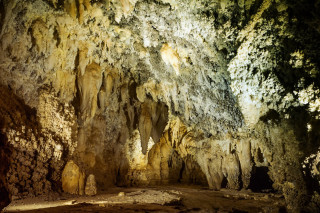Explorer Corps Marker: Utah County
Find the Marker
The Utah County marker is in the landscaped gravel near the entrance to the Timpanogos Cave Visitor Center, located on State Highway 92 in American Fork. It highlights the Timpanogos Cave system, three large limestone caves near the base of Mt. Timpanogos.
GPS 40°26’37.3776”N 111°42’18.378”W
Dig Deeper
At a glance, helictites seem like they don’t pay any heed to the rules of gravity. These cave-formed minerals often seem to grow sideways, or at angles different from vertical, different from other cave formations that are oriented directly up or down. The way water moves through narrow spaces has allowed these cave minerals to take on unexpected shapes, and Timpanogos Cave is home to one of the largest collections of helictites in the world.
You may have driven right by Timpanogos Cave and not even known it. This cave, the centerpiece of its own National Monument, isn’t far from the busy I-15 corridor in Utah County. In fact, the astounding cave was briefly lost soon after its initial discovery. In 1913, the story goes, teenagers James W. Fough and Frank Johnson were visiting Hansen Cave when the two got bored and started poking around the nearby rock ledges. Eventually, they happened upon the entrance to another cave – what would become known as Timpanogos Cave.
But the boys didn’t really know what they had found. It wasn’t until 1921 that a cave explorer named Vearl Manwill relocated the cave and soon found that it was brimming with all sorts of mineral formations. This was a special place, and, worried that the cave might be damaged by other explorers, Manwill and other cavers successfully petitioned to have Timpanogos Cave protected as a National Monument in 1922.

A large part of what makes Timpanogos so special is the variety and number of cave formations inside. Over the course of more than 17 million years, slightly acidic water filtered through ancient limestone to start carving out the caves. This water also carried and deposited minerals as it went, creating an entire garden of cave formations. So far, cave experts have recognized more than 40 different types within Timpanogos Cave. They all have names as unique as their shapes – stalactites, drapery, soda straws, frostwork, flowstones, and moonmilk, just to name a few.
Many of these cave formations are brightly-colored, festooned with shades of yellow and green. That’s not because of algae or bacterial growth, but from minerals dissolved in the cave water. Heavy metals and nickel get deposited as water drips through the caves, giving some of the formations their characteristic colors. This is what time and water can do. One drip at a time, incredible mineral forms take shape.
Naturally, the geologic wonders of the cave are only part of the story. There’s much more to the cave’s past and present. The National Park Service keeps an eye on the bats that call the caves home, especially to keep an eye out for a deadly fungus called white-nose syndrome. Looking to the past, some of the cave layers are part of the ancient Mutual Formation and record some of the earliest animal fossils in Utah. These aren’t body fossils, like shells, but burrows and other traces of squishy life when animals were new on the evolutionary scene. Suffice it to say, Timpanogos Cave has depths.
Want to Go Farther?
Timpanogos Cave is a National Monument, a designation that includes trails and educational programs. If you're ready to spend some time in the canyon or hike to cave trail, make sure to plan your visit in advance and see operating hours and tour schedules. Also, the visitor center is accessible and offers video programs and exhibits about the caves.